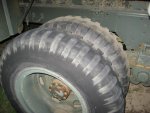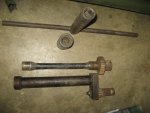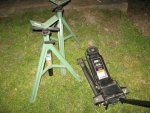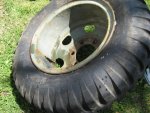builder77sDad
Member
- 70
- 0
- 8
- Location
- Eastham, Massachusetts
One of the inner rear tires on Ethan's deuce is almost bald, but I do have a decent spare. It is time to get some experience changing a flat tire. In fact, I was advised only last week by SS member Daniel (dm22630) to do this at home before having to do it at the side of some road.
Here are the tools Ethan gathered that seem to me to be related to the job. The deuce is on flat clayish dirt, but I will put some plywood down so small wheels will work. I have a deuce manual and will read about this before Saturday, but am wondering if the equipment I have is sufficient from your experience. The axle stands are rated at 2000 lbs, the hydraulic jack at 3.5 ton. I am uncertain how to use the geared lug wrench, but as the handle of the square drive t-wrench fits the hole, I assume this is what to use for leverage.
If anyone wants to assist (or supervise) Saturday starting at tennish, you are welcome. I have a few chairs for supervisors, and we will have burgers to grill. If you want directions to Ethan's house in Richmond, VA (just off 95), send a PM. If anyone would like to share some advice concerning changing tires, this would be appreciated. Helpful advice would include problems or ways to support the axle, remove lug nuts, and handle heavy wheels.
Here are the tools Ethan gathered that seem to me to be related to the job. The deuce is on flat clayish dirt, but I will put some plywood down so small wheels will work. I have a deuce manual and will read about this before Saturday, but am wondering if the equipment I have is sufficient from your experience. The axle stands are rated at 2000 lbs, the hydraulic jack at 3.5 ton. I am uncertain how to use the geared lug wrench, but as the handle of the square drive t-wrench fits the hole, I assume this is what to use for leverage.
If anyone wants to assist (or supervise) Saturday starting at tennish, you are welcome. I have a few chairs for supervisors, and we will have burgers to grill. If you want directions to Ethan's house in Richmond, VA (just off 95), send a PM. If anyone would like to share some advice concerning changing tires, this would be appreciated. Helpful advice would include problems or ways to support the axle, remove lug nuts, and handle heavy wheels.
Attachments
-
43.8 KB Views: 101
-
38.5 KB Views: 118
-
74 KB Views: 113







